Despite a well-received debut at Apple’s Worldwide Developers Conference and promises that iOS 11 would soon create “the largest AR platform in the world,” Apple’s ARKit framework has seen only modest uptake from developers, and growth has been slowing. Apptopia, a third-party provider of app store data, told VentureBeat today that only 825* iOS apps integrated Apple’s ARKit framework between its September debut and the end of 2017, with around half as many integrations per month as there were at ARKit’s launch.
ARKit is an iOS software framework that lets developers easily overlay digital objects and information atop live video from an iPhone or iPad camera. By analyzing live video and motion data from the iOS device, ARKit apps can introduce perspective-shifting 3D virtual characters and structures indoors or outdoors, such as adding a dragon to your backyard or a sofa to your living room. The device’s screen updates the digital objects as you move around and interact with them.

According to Apptopia,* only 300 iOS apps integrated ARKit during its public release in September, which represented the high point of ARKit adoption. Installations fell 32 percent from September to October (205 total) and another 26 percent from October to November (152 total), swinging upward by only 10.5 percent from November to December (168 total).
The ARKit installations constitute a tiny fraction of the 3 million total iOS apps out there, especially when one considers ARKit’s substantial potential for use in games, photo/video apps, and utilities. Apple CEO Tim Cook has opined that “AR is going to change everything,” and noted that Apple is “doing a lot of things” with AR. ARKit has already been integrated into the popular iOS game Pokémon Go and social media app Snapchat, and it’s expected to play a future role in Apple-developed AR glasses, as well.

Currently, Apptopia suggests that 30 percent of ARKit-using iOS apps are categorized as games, 13.2 percent are entertainment, and 7.5 percent are photo & video apps, suggesting the “fun” potential for augmented reality software. Additionally, 11.9 percent of AR apps are utilities, 7.8 percent are educational, and 5.2 percent are lifestyle apps. The remaining 24.2 percent are under the “other” catchall category.
We’ve reached out to Apple for comment on the report and will update this article with any additional details we receive.
Update (*): Rather than taking the opportunity to correct Apptopia’s numbers prior to or immediately after publication of this story, Apple instead included a different figure in a larger App Store sales press release. According to Apple, there are “close to 2,000 ARKit-enabled apps” as of January 4. In a comment to VentureBeat, Apptopia concedes that Apple’s figure is likely accurate, but still believes that ARKit adoption is modest and generally slowing.

